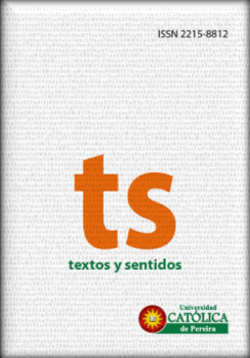Basic and vocational school students learning strategies use and association
Keywords:
Motivation and Learning Strategies Questionnaire (CMEA for Spanish), Learning, Learning strategiesAbstract
This research is aimed to identify significantchanges in cognitive learning strategies association,in 341 primary and secondary students. Hence, aquantitative approach with a correlational scopetransactional design, has been opted. According tothe obtained results, it was possible to identify thatthe correlation between learning strategies tends todecline in relation to the level of schooling, with averified lower association between the tenth andeleventh grades in relation to the eighth and ninthgrades, which correlation values were found higher.Within the conclusions, it is noted that the Elaboration(ELA) learning strategy in the four groups, couldbe associated to the use of guides and ways toimplement the indications in class, which couldpotentially explain the fall in correlation values and,consequently, the little association between the othercognitive learning strategies in the student populationthat served as base for the present study
References
Campo-Arias, A y Oviedo, C. H. (2008) propiedades psicométricas de una escala: la consistencia interna. Universidad Nacional de Colombia. Revista de salud pública, vol 10, (5). Pp: 831-839.
Díaz, A. (1986). El Papel de la Interacción Entre Iguales en la Adaptación Escolar y el Desarrollo Social (Vol. 3). Ministerio de Educación.
Effeney, G., Carroll, A., & Bahr, N. (2013). Self-Regulated Learning: Key Strategies and their sources in a sample of adolescent males. Australian Journal of Educational & Developmental Psychology, 13, 58-74.
Flavell, H.J. 1993. El desarrollo cognitivo. Editorial Antonio Machado. España.
Granados, L.H y Gallego, L F. (2016). Motivación, aprendizaje autorregulado y estrategias de aprendizaje en estudiantes de tres universidades de Caldas y Risaralda. Revista Latinoamericana de Estudios Educativos. 12 (1), (pp. 71-90).
Hernández, S. R, Fernández, C. C y Baptista, L. P (2014). Metodología de la investigación. McGraw Hill, Interamericana. México.
Monereo, C. y Castelló, M. (1997) Las Estrategias de Aprendizaje. Barcelona: Edebé. Monereo, C. (2001) Investigación Educativa: Al Aula lo Que es del Aula. Cultura y Educación, 13(3), 287-293.
Nisbet, J., &Shucksmith, J. (1987). Estrategias de Aprendizaje. Santillana. Madrid.
Pintrich, P. R. (1989). The dynamic interplay of student motivation and cognition in the college classroom. En: C. Ames y M. Maehr (Eds.) Advances in motivation and achievement (Vol. 6). Motivation enhancing environment (pp. 117-160). Greenwich, CT: JAI Press.
Pintrich, P. R. and De Groot, E. V. (1990). Motivational and self-regulated learning components of classroom academic performance. Journal of Educational Psychology 82(1), pp. 33-40.
Pintrich, P.R., Smith, D.A F., García, T. y Mckeachie, W.J. (1993). Reliability and predictive validity of the motivational strategies for Educational and Psychological Measurement 53, pp. 801-813.
Pintrich, P.R. (2000). The role of goal orientation in self-regulated learning. En M. Boekaerts, P.R. Pintrich y M. Zeidner (Eds.), Handbook of selfregulation (pp. 451-502). San Diego, CA: Academic Press.
Pintrich, P.R. (2004). A conceptual framework for assessing motivation and self-regulated learning in college students. Educational Psychology Review. 16 (4), 385-406.
Pozo, J. I. (1990). Capítulo 12. Estrategias de aprendizaje. In Desarrollo psicológico y educación (pp. 199-221).
Pozo, J.I. (1996) Aprendices y Maestros. Madrid: Alianza Psicología Minor.
Pozo, J. I. y Monereo, C. (Coords.), (2000). El aprendizaje estratégico. Madrid: Santillana.
Ramiréz, D. M. C, Canto, J. E, Bueno, A. J. y Echazarreta, M. A. (2013). Validación Psicométrica del Motivated Strategies for Learning Questionnaire en Universitarios Mexicanos. Electronic Jounal of Research in Educational Psychology, 11(1), pp. 193-214. ISSN: 1696-2095. N° 29.
Roces, C., González-Pienda, J.A. y Álvarez, L. (2002). Procesos y estrategias Cognitivas y metacognitivas. En J. González-Pienda, R. González-Rosario, P. Mourao, R., Núñez, J.C., González-Pienda, J., Solano, P. y Valle, A. (2007). Eficacia de un programa instruccional para la mejora de procesos y estrategias de aprendizaje en enseñanza superior. Psicothema, 19, 442-427.
Ruiz, C. (1996). Estilos y estrategias de aprendizaje. Anales de la psicología. 12 Vol 2. P. 121-122. Universidad de Murcia.
Ruiz P, L. M., & Graupera Sanz, J. L. (2003). Competencia Motriz y Género Entre Escolares Españoles. Revista Internacional de Medicina y Ciencias de la Actividad Física y el Deporte, 3.
Schunk, D.H. (2001). Social-cognitive theory and self-regulated learning. En B.J.
Zimmerman y D.H. Schunk (Eds.), Self-regulated learning andacademic achievement: theoretical perspectives (pp. 125-151). Mahwah, NJ: Erlbaum.
Schunk, D.H. 2012. Teorías del aprendizaje, una perspectiva educative. Sexta edición. Always learning, Pearosn. México.
Suárez, J.M., Fernández, A.P. y Anaya, D. (2005). Un Modelo Sobre la Determinación Motivacional del Aprendizaje Autorregulado. Revista de Educación, 338, 295-306.
Tapia, J. (1997 a): Motivar para el aprendizaje. Teoría y estrategias. EDEBÉ. Barcelona. ISBN: 84-236-4346-8.
Valle, A., Barca, A., González, R., & Núñez, J. C. (1999). Las Estrategias de Aprendizaje. Revisión Teórica y Conceptual. Revista latinoamericana de Psicología, 31(3), 425-461.
Weinstein, C. E. y Mayer, R. E. (1986). The teaching of learning strategies. En M. C.
Zimmerman, B. J. y Martínez Pons, M. (1986). Development of a structural interview form assesing of a structural interview form assesing student of self- regulated learning strategies. American Educational Research Journal, 23, 614-628.
Zimmerman. B.J. (1989). A social cognitive view of self–regulated academic learning. Journal of Educational Psychology, 81, 329-339.
Zimmerman, B. J, Martínez-Pons, M. 1990. Students differences in selfregulated learning: relatins grade sex, and giftedness to self-efficacy and strategy use. Journal of educational Psychology, Vol 82 N°. pp. 51-59.

